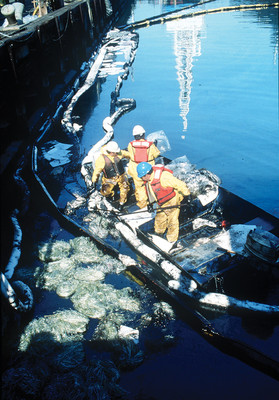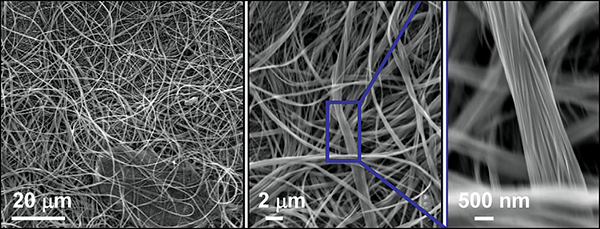
by Erin Wayman Thursday, January 5, 2012

Members of the U.S. Coast Guard use containment booms and absorbent materials to clean up an oil spill. U.S. Coast Guard

Microscopic views of the nanowire paper that may someday clean up oil spills. Francesco Stellacci, MIT and Nature Nanotechnology
After the Cosco Busan container ship crashed into the San Francisco-Oakland Bay Bridge last November and leaked more than 58,000 gallons of fuel into the bay, the U.S. Coast Guard deployed floating containment booms and absorbent pads to mop up the mess. Such technologies have been used to clean up oil spills for two decades. Soon, however, oil spill cleanup crews may have a more high-tech tool: Researchers have developed reusable sheets of nanowire “paper” that absorb oil without soaking up any water.
Francisco Stellacci, a materials scientist at MIT in Cambridge, Mass., and his colleagues used manganese oxide nanowires to create sheets of a fibrous material that look and feel like paper. But unlike regular paper, the nanowire paper absorbs up to 20 times its weight in oil, leaving water behind. “You can take this material and put it in water for a couple of months,” Stellacci says, “and it stays dry.”
To make the material, the team followed a process very similar to making paper, Stellacci says. Wet, suspended strands of nanowires naturally bundle together to form paper-like sheets as they dry. Tiny pores within the mesh of nanowires soak up and store liquids. And by adding a silicone coating to the nanowire paper, the team made it water resistant. In fact, Stellacci says, no other material that he knows of can absorb as much oil while at the same time repelling water.
The nanowire paper is also reusable, giving it another advantage over other oil absorbent materials. Because the nanowires are inorganic, they can withstand higher temperatures than organic material. Heating the nanowire paper to oil’s boiling point evaporates the oil, leaving the nanowire paper clean. Not only is the paper reusable, the oil is too, Stellacci and his colleagues reported online May 30 in Nature Nanotechnology.
Stellacci says he and his colleagues are “talking with many people at this point” about making the technology commercially available. Rolls of the nanowire paper would probably cost roughly $4 per kilogram, which would be affordable, says co-author Jing Kong, a chemist at MIT. Joerg Lahann of the University of Michigan in Ann Arbor, who wrote a commentary on the new research in the same issue of Nature Nanotechnology, says Stellacci and his colleagues have already demonstrated that this technology can be scaled up. And other materials could probably be substituted for the manganese oxide, which can be toxic to animals if it enters the food chain, he says. But, he adds, the real significance of the work is that it provides a blueprint to making nanomaterials that can be applied to solve environmental problems.
Doug Helton, operations coordinator for NOAA’s Emergency Response Program, which deals with oil spills, agrees that “the technology is promising.” Helton says the material’s selectivity appears to be impressive, but he’s not yet sold on the nanowire paper. Although it can be floated on top of oil spills like other oil absorbents, Helton would like to see how the thin material holds up in practice, when oil is often mixed with debris like seaweed, driftwood and sand. He also says using a reusable material out in the field may be a hassle from a logistical standpoint. Instead, he says, the nanowire paper may be more useful in cleaning up oil spills at a “fixed source,” like a refinery, where it might be more manageable to clean up and reuse the paper. Still, Helton says he would welcome adding “another tool to the toolbox.”
© 2008-2021. All rights reserved. Any copying, redistribution or retransmission of any of the contents of this service without the expressed written permission of the American Geosciences Institute is expressly prohibited. Click here for all copyright requests.